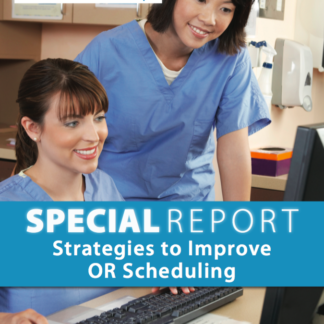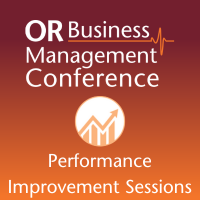Description
This package includes session recordings compiled from Operations breakout and general sessions at the 2022 OR Business Management Conference. After viewing the content, complete a brief quiz and evaluation to earn 7 CEs.
Presentations include:
- Anesthesia: Friend or Foe
- Organize the Chaos and Make Room for Process Improvement and Professional Growth
- Ten Commandments: Rules of Engagement for Strengthening Interdisciplinary Partnerships
- Strategies to Successfully Prepare and Survive a CMS Survey
- Transition from On-site Vendor Endoscopy Processing to Hospital-Based Processing
- Herding Vendors and All the Trays They Carry
- Tame the Beast: Right-Size Your Surgical Supply Inventory
Learn more about the sessions:
Anesthesia: Friend or Foe
Anesthesia providers are vital components of an efficient operating room; however, alignment with these key partners is erratic at best. Therefore we ask, in your perioperative improvement efforts, do you consider anesthesia a friend or foe?
In this presentation, Dr. Robert Stiefel, Enhance Healthcare principal, will discuss reasonable roles and expectations to be provided by anesthesia groups in optimizing OR performance from pre-operative preparation to patient discharge. Examples of mechanisms used to improve alignment, appropriate terms to include in anesthesia contracts, and anesthesia metrics and KPIs will be reviewed. The concepts of Enhanced Recovery After Surgery and the role of your anesthesia partners in these initiatives will be presented as well.
Ultimately, this presentation will provide a framework to align your hospital with your anesthesia providers and create another group of “friends” to help drive operating room performance.
Learning Objectives:
- Describe what role can reasonably be expected from anesthesia providers in improving OR performance.
- Describe the key performance indicators that are available to track anesthesia providers’ role in OR performance.
- Define contractual terms and incentives used to align anesthesia providers with the operating room performance objectives of your leadership.
Organize the Chaos and Make Room for Process Improvement and Professional Growth
The day-to-day logistics of an OR, procedural area, or central sterile supply room are enough to keep hundreds of staff busy 24/7. Concurrent with the core functionality of the department, OR staff are also asked to manage and direct process improvement projects, facilitate change management, develop staff, and create bench strength for their teams. At our organization, we have a culture that is constantly looking for better ways to achieve outcomes and increase efficiency. We start multiple projects and then find our staff trying to determine how to do their “day jobs” plus this work. We needed to align the right people with the right opportunities and find the time to make it happen.
In this presentation, we will outline the tools we used to inventory the capacity of our team members, the daily work taking place, the additional projects we wanted to tackle, and what our staff needed from leadership to grow and develop professionally. This inventory led to a shift both tactically and strategically in how we approach our work, giving special consideration to resource involvement and alignment with long term strategy. We will summarize the benefits we have seen from this change, including clear communication and advancement of work using common templates and work structures, as well as additional allowances for staff to develop professionally. Audience members will be provided with take-home tools to replicate these exercises at their own institutions.
Learning Objectives:
- Describe the processes used to inventory resources and work to identify opportunities.
- Discuss new methodologies to structure the time of team members to allow for routine work, project work and professional development.
- Discuss the common tools to facilitate project advancement.
Ten Commandments: Rules of Engagement for Strengthening Interdisciplinary Partnerships
Market forces and healthcare reform require nimble, creative teams to ensure ongoing delivery of innovative, high-quality care while keeping organizations solvent. Within hospitals, this requires input from many stakeholders including physicians, nurses, and hospital administrators. To be most effective, interdisciplinary alliances must transcend cooperation to form true partnerships. While diverse perspectives have been shown to produce enhanced outcomes, leveraging them is often challenging due to the differences in focus and priorities, distrust, and tension between clinical and non-clinical disciplines.
In this breakout session, the speakers will share their experiences in building strong, interdisciplinary partnerships as well as a framework to support shared governance in their institution. This session will illustrate how galvanizing diverse backgrounds and viewpoints led to cost savings and enhanced patient outcomes.
Learning Objectives:
- Define a framework to support shared governance.
- Identify steps for building interdisciplinary partnerships.
- Discuss characteristics of strong, collaborative partnerships.
Strategies to Successfully Prepare and Survive a CMS Survey
Unannounced CMS surveys are a reality for centers providing surgical services to Medicare and/or Medicaid beneficiaries. Even centers who choose the route of deemed status through accreditation from entities such as JCAHO or AAAHC are not exempt from this anxiety provoking experience, as one could encounter a CMS validation survey following their deemed status survey or a focused complaint survey. Knowledge and understanding of the CMS conditions for participation and corresponding interpretative guidelines provide an awareness as well as a roadmap for overall compliance. Proactive efforts aligned with ongoing preparation and staff awareness of what to expect during the survey process can foster a more positive experience and a successful survey outcome. Attendees will be able to discuss the types of unannounced CMS surveys a facility could expect to undergo; identify proactive activities that can be taken to foster a state of ongoing preparedness; and discuss what to expect during the actual survey process.
Learning Objectives:
- Discus the types of unannounced CMS surveys a facility could expect to undergo.
- Identify proactive activities that can be taken to foster a state of ongoing preparedness.
- Discuss what to expect during the actual survey process.
Transition from On-site Vendor Endoscopy Processing to Hospital-Based Processing
This case study will describe how organizations can successfully transition on-site endoscopy processing from a third-party vendor to on-site coverage. A hospital-based model can significantly reduce cost, facilitate streamlined data management, and, most importantly, improve care delivery.
Proper reprocessing of endoscopy equipment is a critical element of a comprehensive patient safety and infection control strategy in both the inpatient and outpatient healthcare setting.
Surgical services represent both highest cost and the highest operating margin for hospitals within the United States. Surgery represents the most expensive minute in the health care delivery system. Optimizing surgical capacity and efficiency is the key to surgeon satisfaction and to ensuring profitable operations.
Learning Objectives:
- Discuss the historical origin of the SPD and the institutional barriers to success.
- Review the commitment needed from executive leadership to transform the SPD.
- Analyze how transitioning from a vendor supported model to a hospital based coverage is cost effective, and most importantly, improve care delivery.
Herding Vendors and All the Trays They Carry
The purpose of this session is to present our experience with tackling the complex challenges related with vendor tray management. Limited storage space coupled with high volumes of vendor trays and implants have made this process improvement work essential to the successful operations of our busy surgical suite. We will provide you with ideas for implementational change in your own surgical suites.
Learning Objectives:
- Describe how to tailor the utilization of the 5S tool to streamline management of vendors and their trays to handle complex situations.
- Describe how to partner with your vendors to engage them in the process change.
- Discuss how to optimize flow to drive process change.
Tame the Beast: Right-Size Your Surgical Supply Inventory
The surgical supply inventory can be overwhelming, but Cincinnati Children’s Hospital Medical Center (CCHMC) has successfully used a multidisciplinary, data-driven approach to right-size and distribute its surgical supplies. The approach blends data-driven decision making with engagement from frontline clinical staff to make best use of limited staff, space, and budget. CCHMC has identified opportunities for nearly $2 million in savings by reducing low and slow-moving items and adjusting par levels to more closely match supply with demand. Attend this session to discover how to harness the power of data and staff to increase efficiency.
Learning Objectives:
- Discuss how to complement inventory management efforts with data-driven metrics.
- Develop a framework for evidence-based management of surgical supplies.
- Describe strategies for partnering with clinical and nonclinical stakeholders.


